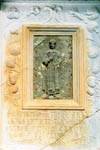|
|
| Byzantine Sculpture |
12th c. (central subject) - 18th c. (surround) Xeropotamou Monastery Serpentine (central subject), white marble (surround) i)(central subject) 40 x 25 cm approx. ii)(surround) 70 x 50 cm |
|

|
The icon is embedded in the wall at the south-west outer corner of the narthex of the katholikon. There are two cracks in the surround and two more in the central subject. The icon is a full-length frontal representation of St Demetrios, wearing a tunic and chlamys and holding a cross in his right hand before his breast. On either side of his head is the inscription: 'Saint Demetrios'. The icon is framed by a succession of marble mouldings surrounded in turn by two tendrils with a variety of flowers, which terminate in the middle of the upper surround on either side of a two-headed eagle. The following inscription in twelve-syllable lines is incised on the lower section of the surround: "+Eις ευπρέπειαν ποίμνης πιστών ανάκτων αδραίς δαπάναις την δ' ήνεγκεν εκ ναού της αγίας Σοφίας πείσας ζακόρους οικουμενικού σύγκελλος Γρηγόριος" (For the grace of the flock of the faithful kings, the senior patriarchal archimandrite, Gregory, persuaded the church officials and at great expense brought this icon from the Church of Hagia Sophia). The icon itself is believed to be a twelfth-century work, though it in fact reflects an iconographical type that is common in earlier pictorial monuments and works of minor art, though not entirely absent from the middle Byzantine period. The work is distinguished by a simple yet expressive execution. The saint's body is flat, and the vertical, tubular folds of his clothing give no hint of what lies beneath. All the same, the linearity stops short of geometric abstraction, for the fall of the folds emphasises the vertical motion, in much the same way as the fluting on a column. This relief is from Hagia Sophia in Constantinople, if the inscription on the later surround is to be believed. The surround must have been made after the katholikon was founded in 1761 and certainly before the end of the eighteenth century, for the 'faithful kings' mentioned in the inscription are none other than Romanos I, Constantine VII Porphyrogennitos, and Andronicos II Palaeologos, who are repeatedly mentioned in eighteenth-century inscriptions in Xeropotamou (see Millet - Pargoire - Petit 1904, nos. 541, 561-3).
| |
|
Bibliography: Smyrnakis 1903, p. 547. Millet - Pargoire - Petit 1904, no. 539b. Brockhaus 1924, pp. 43-4, pl. 9. Lange 1964, no. 23, p. 79.
| ||
| T.N.P. | ||
| Index of exhibits of Monastery of Xeropotamou 12th century |
||
Reference address : https://www.elpenor.org/athos/en/e218bf8.asp